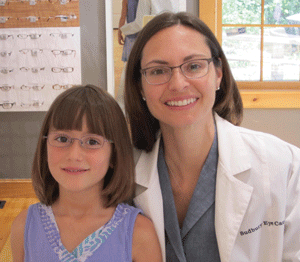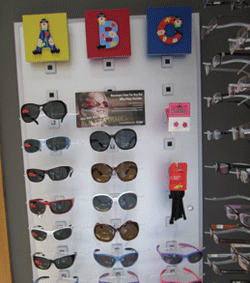A few years ago, I decided to go solo and open a new practice.

Selling kids glasses may seem like an afterthought, but it can be a profit center. Dr. Lorraine Labiento Smith (pictured here with patient Emily) has turned it into a nice niche business.
However, our small town already had both a well-known optician and a national chain.
These businesses were established, while I was starting from scratch and on a budget. How could I compete?
Rather than opposing them head-on, I decided to look for a niche.
Our town is an outer suburb of Boston that is very popular with families.
Looking around, I saw many other businesses—doctors, dentists, salons and clothing stores—that had achieved success by catering to the children’s market.
I found out that nearly one-third of our residents (32.5%) are under age 18. Moreover, we are surrounded by other family-oriented communities.
I was convinced that all these children represented an opportunity for my eye care practice.
Building a Better Option
In researching the market, I found few options for children’s eye care. Most eye care professionals provide a one-size-fits-all experience.
However, they really aren’t very family friendly. Their stores—full of fragile frames and sharp corners—aren’t designed to be comfortable for parents with small kids. And their selection of children’s frames leaves a lot to be desired.
I decided that my niche would be the opposite: An optical designed to make families feel comfortable, with a wide selection of fashionable children’s eyewear that both kids and their parents would love.
From our humble beginnings, we’ve grown beyond my expectations. Today, patients come to us from more than 40 surrounding towns, and we enjoy very high rates of customer loyalty and referrals.
As our profits have grown, we’ve reinvested back in the practice—expanding our selection of frames, investing in new, state-of-the-art equipment, and buying and remodeling a building for our newly expanded optical.
Our success should not be an isolated story. According to the 2010 Census, there are 82 million children under the age of 18 in the US—more than a quarter of the total population. And, the World Health Organization estimates that between 5% and 15% of children have a refractive error.
So, I’m convinced there’s an opportunity to create profitable children’s opticals in many other communities. However, in order to take advantage of this opportunity, optometrists will need to think differently about their practices.
Here are the most important lessons I learned from building a children’s optical in my practice:
Find a Family Community
The single most important factor in creating a successful children’s optical is to find the right community. If you’re going to serve kids, you should be in a market where lots of kids live.
Not only does this give you a patient base to serve, it also provides you with a network of professionals and organizations that can provide referrals, be involved in collaborative marketing and publicity opportunities, and offer general support and advice to help grow your practice.
How do you find the right community? Start by looking for highly-ranked school districts. Strong school systems tend to attract families that are committed to investing in their children’s well being.
Also, look for complementary businesses that serve children, such as pediatricians, pediatric dentists, dance studios, children’s salons and clothing stores. If others make a nice living serving families with children, that’s a good sign that you can, too.
Market to Moms
Having a children’s optical is different from a normal, retail optical because many prospective customers don’t realize that they need you. Even if you have a prime retail location, many parents will never bring their kids in the door because they don’t consider going to the eye doctor as a part of their children’s health routine.
Instead, parents learn they might need your services through school screenings, pediatrician visits, educational outreach and word of mouth. Then, they research options on the Internet.
When we were opening, I didn’t have the budget for a prime location. So, I started off with an inexpensive office on the second floor of a professional building. I didn’t even have a street sign.
To compensate, I spent a lot of time building relationships with pediatricians, school nurses, ophthalmologists and community organizations. Many of my patients come from these professional referrals. In addition to referrals, I advertise, have a website and am listed in insurance directories.
Always remember this: You may be serving kids, but moms make the decisions. So your marketing should really target moms rather than children.
And remember, parents have jobs and need flexible office hours. The peak times for kids are weekday afternoons from 3 to 6 o’clock.
|
|
Petite Frames Aren't Just for Children
|
|
|
|
As I began selling children’s frames, I
noticed something unexpected: Moms kept trying on the frames. The tweens
frames fit petite women perfectly!
I have a nice
following and when I sell to a petite woman, it’s always a multi-pair
sale. When I attend trade shows, I look for frames with small eye sizes
in mature colors and higher-end design for this small (that is, petite!)
population.
|
|
Be Visible Online
Whether the patients came through referrals, advertising or insurance company provider directories, they almost all have something in common: they research on the Internet before choosing a doctor or optical.
For this reason, our website has been the most important factor in attracting new patients.
Our site is not fancy, and was actually very inexpensive to develop. However, it does two things very well:
First, it gets us found on search engines, so that when someone searches for terms like “children’s glasses” or “pediatric optical” in our local area, we come out at the top or near the top of the rankings.
Second, it provides patients with the medical and optical information they need in order to evaluate and trust us.
Design a Family-Friendly Optical
It’s very helpful to actually be a parent before going into this niche. After I became a parent of young children, my perspective on opticals changed dramatically.
I no longer focused solely on the beautiful fixtures and frames.

Locate the children’s waiting area away from the optical—but make it fresh, bright and fun.
In designing my optical, I tried to make it family friendly, while still preserving the aesthetics and merchandising of a good retail setting.
This starts with the waiting area. I placed the waiting area away from the optical so they cannot grab the eyeglasses—a big cause of parental stress.
All of our outlets have safety covers. I minimized sharp corners, pinch points and tempting fragile things that kids might grab and break.
I tried to make it an area in which kids wouldn’t mind waiting.
There is age-appropriate entertainment (origami for the older kids), some kid-sized furniture and the never failing fish tank.
Finally, I worked with my fixture design company and frame reps to merchandise the frames.
We came up with a variety of fun displays for different categories—tweens, tots, sports and sunglasses. We also tried to give them a “kid feel” while still offering fashion and quality.
Pick the Right Frames
How do you get started? Here is a crash course. The pediatric market is divided into three distinct groups: ages zero to three, three to seven, and eight to 14.
I originally started with about five different frame styles for each gender in each category, and expanded as I grew.
- 0 to 3. For babies and toddlers, basic durable eyeglasses are sold in kits of six to eight different frame styles and color samples. The two categories are the nylon one-piece designs and the semi-custom metal frames (e.g., Fisher Price).
With these kits, the optician has a lot of control over the frame front, nose bridge and temple design, and the parent chooses the color palette.
- 3 to 6. In buying frames for this age group, it’s important that they are well made and come with a good warranty. I look for smaller manufacturers because the quality is better and they don’t market TV icons.
Kids like to choose their favorite colors, so offer bright colors with cute details. Instead of stocking a huge inventory, keep some specialty catalogs on hand.
- 8 to 14. Pre-teens: need I say more? Actually, this is a very fun group and I have the largest selection in this area. Tweens have very definite opinions about style and trends.
Our job is to provide direction in appropriate fit and use of the prescription.
Important note: Pick contemporary styles and choose a single manufacturer’s complete line. It is simpler, more cost effective and easier to market.
Even if you only carry one line, make sure there are multiple size and color options available. My number one line is Ocean Pacific.

Fun frame boards appeal to kids—but still offer fashion and quality to win over parents.
They target tweens to young adults, are well made, trendy, have many size and color options, and have a good exchange policy.
Because children’s needs vary, I prefer to custom order the correct sizes and colors as needed rather than stock excessive inventory.
The parents will recognize the extra effort and their loyalty is ensured. Be sure to provide protective eyewear and sunglass options that are prescription ready.
Offer a reasonable sunglass package and you will easily sell multiple pairs.
Before you sell, educate! Discuss the prescription, frame benefits, warranties and wearing schedule.
My practice is 98% premium anti-glare.
It is an easy up-sell and I believe it’s important to the success of the prescription.
Why premium? Kids are messy and always have smudged lenses.
These lenses are easier to clean and have stronger scratch-resistant coating. Parents rarely turn down this option.
To succeed in the cost-driven competitive optical business, doctors need to find opportunities to provide unique services to their patients. A pediatric section added to an adult optical can provide such an opportunity.
A small investment caring for an underserved population will increase patient numbers and lead to increased optical and medical profits. Plus, it’s a lot of fun!
Dr. Labiento Smith is a former staff optometrist at Massachusetts Eye and Ear Infirmary, and now practices in Sudbury, Mass. Mr. Smith is the practice’s VP of marketing.

